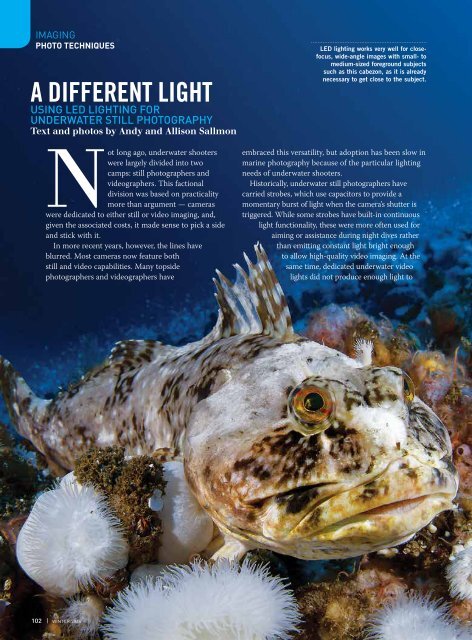AD 2016 Q1
You also want an ePaper? Increase the reach of your titles
YUMPU automatically turns print PDFs into web optimized ePapers that Google loves.
IMAGING<br />
PHOTO TECHNIQUES<br />
A DIFFERENT LIGHT<br />
USING LED LIGHTING FOR<br />
UNDERWATER STILL PHOTOGRAPHY<br />
Text and photos by Andy and Allison Sallmon<br />
Not long ago, underwater shooters<br />
were largely divided into two<br />
camps: still photographers and<br />
videographers. This factional<br />
division was based on practicality<br />
more than argument — cameras<br />
were dedicated to either still or video imaging, and,<br />
given the associated costs, it made sense to pick a side<br />
and stick with it.<br />
In more recent years, however, the lines have<br />
blurred. Most cameras now feature both<br />
still and video capabilities. Many topside<br />
photographers and videographers have<br />
LED lighting works very well for closefocus,<br />
wide-angle images with small- to<br />
medium-sized foreground subjects<br />
such as this cabezon, as it is already<br />
necessary to get close to the subject.<br />
embraced this versatility, but adoption has been slow in<br />
marine photography because of the particular lighting<br />
needs of underwater shooters.<br />
Historically, underwater still photographers have<br />
carried strobes, which use capacitors to provide a<br />
momentary burst of light when the camera’s shutter is<br />
triggered. While some strobes have built-in continuous<br />
light functionality, these were more often used for<br />
aiming or assistance during night dives rather<br />
than emitting constant light bright enough<br />
to allow high-quality video imaging. At the<br />
same time, dedicated underwater video<br />
lights did not produce enough light to<br />
102 | WINTER <strong>2016</strong>









